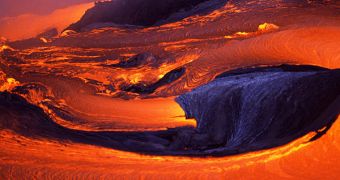Recently an alternative theory designed to contest the notion that Earth's mantle, the layer between the outer crust and the inner core, might have been solid, suggests that instead it could have consisted of a thick magma 'ocean', slowly flowing beneath the surface.
Evidence collected from seismic events during the last decade shows the possible presence of thin magma pockets in the lower regions of the solid mantle. According to Stephane Labrosse of the Ecole Normale Superieure de Lyon, all scientific evidence points towards a cooling process that has taken place for most of the history of the Earth, meaning that if there is still magma deep under the surface, it must have been more in the past.
The Labrosse team comes with a model in which the mantle might have been formed of a magma ocean with two distinct layers of molten rock, as a result of the heat generated in the Earth's core. John Hernlund, geophysicist at the University of British Columbia suggests that the upper layer of the ocean could have been up to 1,000 kilometers thick, and was formed during the multiple asteroid impacts in Earth's early life. The heat resulted in the collisions would have been enough to liquify the whole surface of the planet, however it could have turned solid in about 10 million years.
Labrosse's theory implies that heat radiating from Earth's central core also melted the lower layer of the mantle, which produced a layer of solid rock between the core and the ocean of magma on the surface of the planet. This theory could possibly resolve one of the other mysteries related to the heavy metal composition of our planet. Since the planet forming model postulates that Earth was formed from a mix of meteorites and large asteroids, this would also mean that the planet's composition would have to closely match that of the meteorites.
However, for Earth this is not true especially when it comes to heavy elements such as uranium present in relatively small quantities on our planet, while meteorites are abundant with radioactive heavy elements. This implies that these heavy radioactive elements might have sunk under the influence of gravity being collected in the lower regions of the magma ocean, which could also explain the relatively small quantities present in the upper layer of the mantle.
Nevertheless, this theory presents a small problem. The presence of the heavy metals inside the lower regions of the mantle would have given the magma ocean a relative radioactivity that could possibly keep the magma liquid for a few billion years, which would have delayed the cooling process for Earth to generate the magnetic field.
This means that the liquid iron core that produces the magnetic field could not have been created for more that a billion years after the planet formed, thus the solar wind and the cosmic rays would have shaped the atmosphere very early on, when the magnetic field was not available.
Evidence of the former magma ocean can be seen in seismic waves from earthquakes, which are used to study the border between the core and the mantle, which bend and bound oddly in so-called 'mushy' patches in the lower regions of the mantle.

 14 DAY TRIAL //
14 DAY TRIAL //